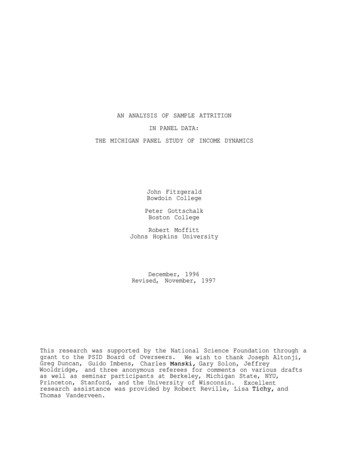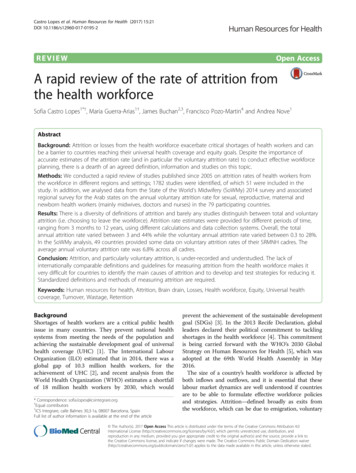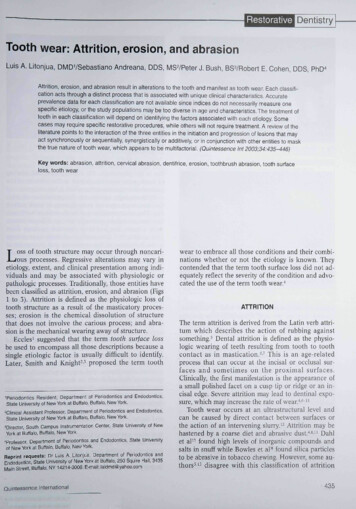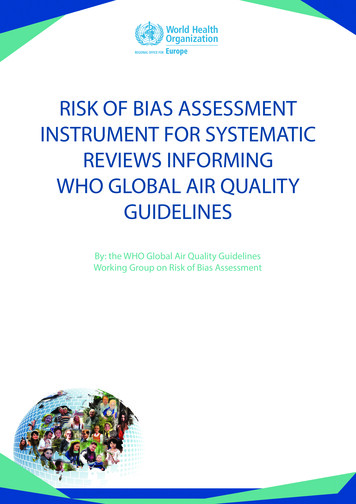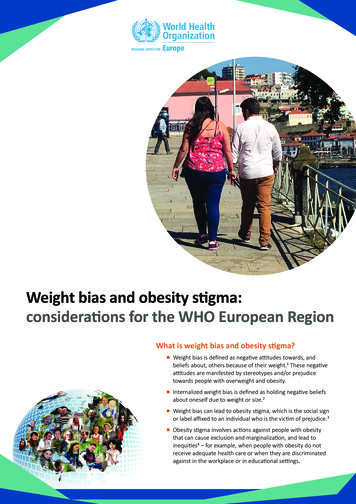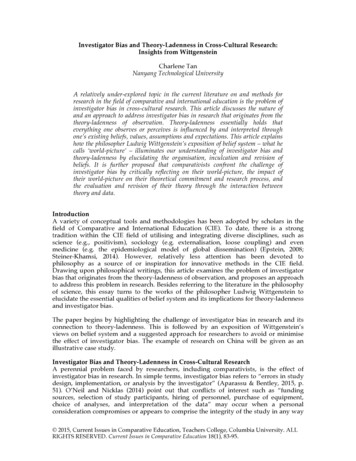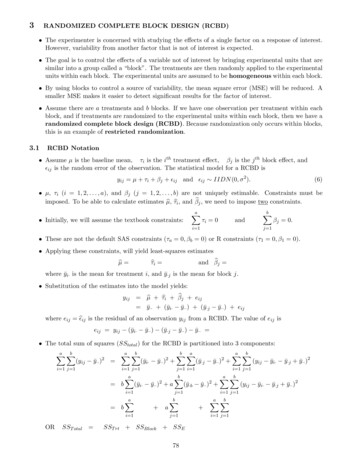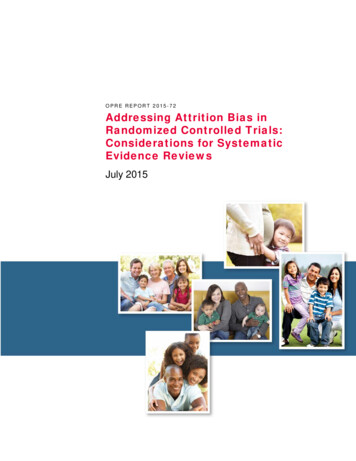
Transcription
OPRE REPORT 2015-72Addressing Attrition Bias inRandomized Controlled Trials:Considerations for SystematicEvidence ReviewsJuly 2015
OPRE REPORT 2015-72Addressing Attrition Bias inRandomized Controlled Trials:Considerations for SystematicEvidence ReviewsJuly 2015John DekeEmily Sama-MillerAlan HersheySubmitted to:Office of Planning, Research and EvaluationAdministration for Children and FamiliesU.S. Department of Health and Human ServicesProject Officer: Seth ChamberlainContract Number: HHSP23320095642WC/HHSP23339025TSubmitted by:Mathematica Policy Research1100 1st Street, NE12th FloorWashington, DC 20002-4221Telephone: (202) 484-9220Project Director: Sarah AvellarReference Number: 06969This report is in the public domain. Permission to reproduce is not necessary. Suggested citation: Deke, John,Emily Sama-Miller, E., and Alan Hershey, A. (2015). Addressing Attrition Bias in Randomized Controlled Trials:Considerations for Systematic Evidence Reviews.” Washington, DC: Office of Planning, Research and Evaluation,Administration for Children and Families, U.S. Department of Health and Human Services, 2015.Disclaimer: The views expressed in this publication do not necessarily reflect the views or policies of the Office ofPlanning, Research and Evaluation, the Administration for Children and Families, or the U.S. Department of Healthand Human Services.This report and other reports sponsored by the Office of Planning, Research and Evaluation are available athttp://www.acf.hhs.gov/programs/opre.
IDENTIFYING AND ADDRESSING ATTRITION BIASMATHEMATICA POLICY RESEARCHCONTENTSOVERVIEW . 1I.INTRODUCTION. 2II.BACKGROUND . 2III.THE ATTRITION STANDARD . 4IV.ARE WWC’S ASSUMPTIONS ABOUT ATTRITION SUITABLE FOR HOMVEE? . 7V.AExamining the parameter values for the attrition model . 7BChecking how much our definition of “acceptable” bias affects the boundary . 9DISCUSSION . 12REFERENCES . 14APPENDIX . 15iii
IDENTIFYING AND ADDRESSING ATTRITION BIASMATHEMATICA POLICY RESEARCHOVERVIEWA well-executed randomized controlled trial (RCT) can provide highly credible evidenceabout program efficacy, but this credibility can be weakened if there is substantial attrition (thatis, people leaving the study sample). If the characteristics of the people who leave are correlatedwith their group status or outcomes, this correlation could create systematic differences betweenthe remaining program and control group members. This in turn could lead to biased estimates ofprogram effects; the risk of bias (that is, a systematic difference between the true program impactand its estimated impact on the sample of people analyzed) increases with the attrition rate.These issues are critical for systematic evidence reviews that assess existing studies onprogram effectiveness, such as the Home Visiting Evidence of Effectiveness Review(HomVEE). These reviews typically focus on RCTs and other studies that are sufficiently welldesigned to conclude that a program caused an observed effect. Attrition could introduce bias, sosystematic reviews are concerned with knowing its level in a study relative to a tolerable level inorder to assess the validity of RCTs.HomVEE uses an attrition standard adapted from the Department of Education’s WhatWorks Clearinghouse (WWC), another systematic evidence review. This standard establishestolerable rates of attrition for the RCTs reviewed by HomVEE. 1 The standard is a boundarybetween high and low rates of overall attrition and differential attrition (the difference in therates of sample loss for the program and control groups). Attrition rates above this boundaryyield an unacceptably high bias. For these reviews, the maximum acceptable bias is 0.05standard deviations.HomVEE’s population of interest includes pregnant women, and families with children agebirth to kindergarten entry; the population is different than the school-age children whose testscores were the basis of the attrition standard for the WWC. Therefore, we conducted a statisticalexercise to examine how the HomVEE attrition boundary would respond to changes in twofundamental assumptions: (1) the correlation between outcomes and attrition and (2) the level ofattrition bias deemed “acceptable.” Data came from the Early Head Start Research andEvaluation Project, in which 7 of 17 sites delivered Early Head Start primarily via home visits,and from effect sizes reported in HomVEE-reviewed studies through September 2014.The results suggest two main conclusions. First, the HomVEE attrition boundary isrelatively insensitive to changes in the assumed correlation between outcomes and attrition.Second, the attrition boundary is sensitive to how HomVEE defines an “acceptable” level ofattrition bias. Specifically, when small impacts matter, small biases (possibly resulting fromattrition) also matter.As a principle of well-executed social science research, researchers attempting to detectsmall impacts must also worry about small biases and should strive for the lowest possibleattrition rate in their studies, including rates lower than those permitted by HomVEE standards.1For more information, visit the HomVEE website (http://homvee.acf.hhs.gov/) and the WWC website(http://ies.ed.gov/ncee/wwc/).1
IDENTIFYING AND ADDRESSING ATTRITION BIASI.MATHEMATICA POLICY RESEARCHINTRODUCTIONA well-executed randomized controlled trial (RCT) can provide highly credible evidenceabout program efficacy. Because study groups are formed randomly, researchers can assume thegroups are equivalent on average in all respects except that only one group receives a programthat is being tested. Therefore, any statistically significant differences between the outcomes ofthe groups at the end of an evaluation can be attributed to the program rather than to otherfactors.The credibility of RCTs, however, can be weakened if there is substantial attrition. Ifcharacteristics of people who leave the sample are correlated with their group status or outcomes,the correlation may point to systematic differences between the remaining program and controlgroup members. This could lead to biased estimates of program effects. Because researcherstypically cannot fully understand why some sample members leave they may not know whetheror how the leavers’ characteristics are related to their group status or their outcomes. Thus, as theattrition rate rises, so does the potential for bias.These issues are critical for the Home Visiting Evidence of Effectiveness Review(HomVEE). HomVEE focuses on studies of home visiting programs targeting pregnant womenand families with children from birth to kindergarten. The review identifies, assesses, and ratesthe rigor of impact studies of home visiting programs that serve this population. HomVEEfocuses on studies that are sufficiently well designed to estimate programs’ effects, apart fromother factors that may influence the target population.HomVEE uses an attrition standard adapted from the Department of Education’s WhatWorks Clearinghouse (WWC). This standard establishes tolerable rates of attrition for the RCTsreviewed by HomVEE. 2 In this paper, we discuss whether an attrition standard based oninformation from education research is appropriate for use with the research that HomVEEexamines. The paper also provides an example of how to assess whether the attrition standard forone systematic evidence review fits other systematic reviews, along with considerations foradopting or modifying the standard for alternative contexts.II. BACKGROUNDRCT studies use a rigorous design and may receive the highest possible ratings of causalvalidity in both the HomVEE and WWC reviews. 3 However, excessive sample attrition willpreclude such a rating. An RCT with high attrition (as defined by the attrition standard describedbelow) can receive no more than a “moderate” rating in HomVEE. Further, high-attrition RCTsmay earn that mid-level rating only if researchers can show that selected characteristics of the2For more information, visit the HomVEE website (http://homvee.acf.hhs.gov/) and the WWC website(http://ies.ed.gov/ncee/wwc/).3The study-level ratings—(1) high, (2) moderate, and (3) low—provide a measure of the review’s degree ofconfidence that the study design could provide unbiased estimates of model impacts.2
IDENTIFYING AND ADDRESSING ATTRITION BIASMATHEMATICA POLICY RESEARCHprogram and control groups were equivalent at baseline (before enrollment into the program). 4Therefore, the rate of attrition is an important consideration when these reviews assess thevalidity of RCT studies.The attrition standard, described in the next section relies on two measures of attrition—overall and differential—to assess whether the attrition rate is large enough to introduce anunacceptable level of bias (that is, a systematic difference) between the true and estimatedimpact on the analytic sample. The measures are defined as follows: Overall attrition rate: the proportion of sample members randomly assigned to the studygroups for whom outcome data are not available Differential attrition rate: the difference in attrition rates between the program and controlgroupsRandom assignment produces groups that are similar on average, but overall and differentialattrition may lead to groups that have different baseline characteristics. This can result in biasedconclusions about a program’s efficacy. In other words, the evaluation may capture the impact ofthe characteristics that differ between the groups in addition to the program’s impact.Researchers can neither observe nor statistically control for all possible factors that lead toattrition, so it is difficult or impossible to eliminate this type of bias when calculating effects. 5WWC’s and HomVEE’s attrition standards are not concerned with sample loss that isexogenous (unrelated to an individual’s random assignment status) because it does not introducebias. For example, researchers facing budget constraints may collect follow-up data from onlysome randomly assigned sample members. This is acceptable as long as the researchersrandomly choose the sample members for follow-up. Excluding sample members randomly doesnot introduce bias because doing so is clearly unrelated to their treatment status.Conversely, losing sample members because of nonrandom events that occur after randomassignment is problematic because it may introduce bias. For example, if sample members areasked to consent to the evaluation after random assignment, the loss of people who do notconsent introduces the possibility of bias because sample members might decide whether toconsent based on their group assignment. This can lead to differences between the groups in thenumber and characteristics of sample members who leave the study. If this happens, there is abigger risk that a significant difference in outcomes between the program and control groups willbe attributed to the program when in fact it is due to characteristics that caused sample membersto consent or refuse.The WWC has consistently recognized that attrition can undermine the estimates of an RCT,but its specific attrition standard has evolved. The original standard consisted of cutoff values for4See ng-Study-Ratings/19/5 andhttp://ies.ed.gov/ncee/wwc/pdf/reference resources/wwc procedures v2 1 standards handbook.pdf) for details.5Readers seeking more information on the concept of attrition bias and strategies for mitigating it might find helpfulexplanations in a recently released brief prepared by HomVEE staff:http://homvee.acf.hhs.gov/HomVEE brief 2014-49.pdf.3
IDENTIFYING AND ADDRESSING ATTRITION BIASMATHEMATICA POLICY RESEARCHoverall and differential attrition rates. 6 The cutoff for the overall attrition rate was similar to thesurvey response rates targeted by federal agencies such as the Office of Management and Budget(OMB) and the National Center for Educational Statistics (NCES). 7 OMB, NCES, and WWCchoose these cutoffs out of concern about nonresponse bias, but there is no theoretical orempirical evidence that such cutoffs limit bias. The WWC Statistical, Technical, and AnalyticalTeam (STAT) therefore developed a model of attrition and analyzed data from past educationrelated RCTs to help select parameter values for that model. 8 Essentially, the model estimates theexpected attrition bias, using assumptions about the relationship between outcomes and theintrinsic likelihood that sample members will leave the sample. The STAT used the model tocalculate the expected bias for every combination of overall and differential attrition rates. Thecombinations along the boundary represent the maximum acceptable level of bias. WWC andHomVEE now refer to this maximum acceptable level as the attrition standard. The next sectionmore fully explains how the standard was developed.III. THE ATTRITION STANDARDThe attrition standard for WWC and HomVEE is a boundary between high and low rates ofoverall and differential attrition (Figure 1). Attrition rates above this boundary (the red area ofthe figure) yield an unacceptably high bias; rates in the green area are acceptably low. Lowoverall and differential attrition rates are preferable, but there is some flexibility. High rates ofoverall attrition may be acceptable when the differential attrition rate is very low, and the reverseis true as well.6WWC reviews are organized by topic areas such as literacy. Originally, the principal investigator for each topicarea selected the attrition rate cutoff value for the studies reviewed in that topic area. These cutoffs ranged from 20to 30 percent for the overall attrition rate and from 5 to 10 percent for the differential attrition rate.7OMB’s target response rate is 80 percent for data mc survey guidance 2006.pdf), and NCES’s target response rate is85 percent (http://nces.ed.gov/pubs2003/2003601.pdf). Because OMB and NCES guidelines focus on general datacollection (not just RCTs), they do not include targets for the differential attrition rate.8Dr. John Deke led the development of the WWC attrition model and the accompanying attrition standard, which isdescribed in Appendix A of the What Works Clearinghouse Procedures and Standards Handbook, version 2.1(http://ies.ed.gov/ncee/wwc/pdf/reference resources/wwc procedures v2 1 standards handbook.pdf); the model ispresented in the WWC white paper on assessing attrition bias:http://ies.ed.gov/ncee/wwc/pdf/reference resources/wwc attrition v2.1.pdf.4
IDENTIFYING AND ADDRESSING ATTRITION BIASMATHEMATICA POLICY RESEARCHFigure 1. WWC and HomVEE attrition boundsNote:This is a stylized illustration of attrition boundaries, so the dividing line in the diagram may not preciselyreflect the calculated boundary. Table 1 provides specific values that lie on the boundary.To more precisely illustrate the concept in Figure 1, Table 1 presents some specific attritionrates that lie on the boundary. The left column lists overall attrition rates, and the right columnlists the differential attrition rate that corresponds to the placement of the attrition standardboundary for that overall attrition rate.Table 1. Maximum acceptable rate of differential attrition for each overallattrition rateOverall attrition rateMaximum acceptable rateof differential ource: Authors’ calculations using the attrition model with WWC’s “conservative” parameter assumptions (whichare also used by HomVEE).5
IDENTIFYING AND ADDRESSING ATTRITION BIASMATHEMATICA POLICY RESEARCHSelecting the position of the attrition boundary depends on complex decisions about: The statistical model that defines the boundary The assumptions made about the relationship between outcomes and attrition The amount of bias considered tolerableMaking realistic assumptions about how attrition relates to outcomes is challenging becausethe outcomes for sample members who leave are, by definition, unknown. Researchers thereforecannot directly observe the relationships of interest. Instead, the WWC STAT indirectlyestimated this relationship using data from past RCTs in education. The team used academic pretest scores (which were available for all randomized students in the past studies) as a proxy forpost-test scores (which were missing for some of the randomized sample). The STAT assumedthat the relationship between the attrition rate and pre-test scores was the same as the relationshipbetween the attrition rate and post-test scores. This was because academic pre- and post-testscores are often highly correlated. 9Researchers must also decide what level of attrition to allow. The STAT addressed thischallenge by selecting a level that was low relative to WWC’s definition of a substantivelyimportant impact (0.25 standard deviations of the outcome variable). The team definedmaximum acceptable bias as one-fifth of a substantively important impact, or 0.05 standarddeviations. Attrition bias exceeding this level of 0.05 is considered unacceptably high.The STAT used data from education research to develop two attrition boundaries for WWC:optimistic and conservative. WWC uses the optimistic boundary when it seems reasonable toassume that attrition is only weakly related to the program and outcomes. This boundary isconsistent with actual correlations between the attrition and pre-test scores observed in RCTsinvolving children in grades 1 through 9, as well as in curricular interventions the STATexamined when making assumptions about the attrition model parameters. WWC uses theconservative boundary when attrition is likely to be strongly related to the program andoutcomes—for example, in studies focusing on drop-out prevention. The likelihood of droppingout of school may be highly correlated with the likelihood of attrition during follow-up datacollection. 10HomVEE adopted the conservative boundary from WWC, and does not use the optimisticboundary.9The correlation between academic pre-tests and post-tests is typically 0.7 to 0.8 (Bloom et al. 2005; Schochet2008).10Principal investigators for WWC topic areas may choose which boundary should be used for reviews in theirareas. See http://ies.ed.gov/ncee/wwc/pdf/reference resources/wwc procedures v3 0 standards handbook.pdf,page 12. Once a principal investigator selects a boundary, it is used for all RCTs in that topic area.6
IDENTIFYING AND ADDRESSING ATTRITION BIASMATHEMATICA POLICY RESEARCHIV. ARE WWC’S ASSUMPTIONS ABOUT ATTRITION SUITABLE FOR HOMVEE?HomVEE and WWC focus on different research populations, and thus HomVEE might needto choose different attrition model parameters or cutoffs for acceptable attrition bias. Woulddoing so change the attrition boundary? If the boundary is affected by small changes in theparameter or cutoff values, it may be appropriate to assess whether the WWC-based values areappropriate for HomVEE. If the boundary is not affected by changes in the two factors, we canbe more confident about HomVEE’s existing evidence standards. Our approach to testing each ofthe two factors, while leaving the other unchanged, is described below.A. Examining the parameter values for the attrition modelWe cannot observe (and therefore must assume) the correlations between outcomes and thelikelihood of attrition, but what if our assumptions are wrong? To answer this question, weconducted two analyses. First, we used real data from HomVEE to examine the WWCStatistical, Technical, and Analytical Team’s assumption that pre-test measures are reasonableproxies for post-test measures when defining parameter values for the attrition model. Second,we conducted a thought experiment testing a wide range of parameter values to examine whetherand how they affect the boundary.Are baseline variables a good proxy for outcomes in an early childhood setting? Theselection of attrition model parameters for WWC was informed, in part, by analyses of data fromRCTs in education research, a field with a generally high (70 to 80 percent) correlation betweenpre- and post-tests. To assess whether similar analyses could inform the selection of parametervalues for the HomVEE attrition model, we analyzed data from the Early Head Start Researchand Evaluation Project (EHSREP; Love et al. 2002), one of the largest experimental evaluationsof an early childhood intervention. Seven of 17 EHSREP sites delivered Early Head Startprimarily via home visits.We examined 70 outcomes (Table A.1) from several areas of interest to HomVEE: (1) childhealth, (2) maternal health, (3) cognitive development, 11 (4) social-emotional development,(5) parenting, (6) family economic self-sufficiency, (7) family violence, and (8) linkage andreferrals to other services in the community. We used 58 baseline variables (Table A.2) topredict each outcome using a regression. The adjusted R2 statistic resulting from the regressionquantified the proportion of the variation in each outcome that these baseline variables predicted.Across the 70 regressions, the adjusted R2 ranged from 0 to 0.14, with a median of 0.04. That is,the baseline variables usually explained less than 5 percent of the variation in the outcome.We found that baseline variables, therefore, likely do not reliably predict outcomes in earlychildhood research; knowing baseline scores is less useful for predicting outcomes for youngchildren than for older children. Only 10 of the 70 regressions indicated (through their adjustedR2) that at least 10 percent of the variation in the outcome was explained by the baselinevariables. The STAT successfully used the correlation between baseline scores and the attrition11HomVEE uses a single outcome domain to encompass children’s cognitive and social-emotional development, butEHSREP considered these separately.7
IDENTIFYING AND ADDRESSING ATTRITION BIASMATHEMATICA POLICY RESEARCHrate to approximate the correlation between outcomes and attrition, but these findings make usless confident that we could do the same in HomVEE.Given our findings, we do not recommend conducting a WWC-style analysis to selectparameter values for a HomVEE attrition model. Unless we can find better predictors throughadditional research, it does not make sense to refine the attrition model to apply specifically tothe HomVEE context. Instead, we next examined how a range of hypothetical parameter valuesaffect the boundary.How do relatively large changes in assumptions about the model parameters affect theattrition boundary? Increasing the correlation between attrition and outcomes increases bias.So does increasing the difference in correlation between the program and control groups. But towhat extent is bias affected by these correlations? We tested how various correlations mightaffect the level of bias by using a range for correlations for each assumption.We used the formulas for the WWC attrition model to calculate the average attrition bias atthe boundary. These calculations were based on three alternative assumptions (which could becharacterized as weak, moderate, and strong) about the correlations between the attrition andoutcomes and the difference in these correlations between the program and control groups(Figure 2). Specifically, we combined: Three assumptions of the overall correlation between attrition and outcomes (r 0.22, 0.42,and 0.62) with Three assumptions of the difference in that correlation between the program and controlgroups (r 0.03, 0.06, and 0.12)For example, in combining the assumption of r 0.22 with r 0.12, we assumed a relativelyweak relationship between the attrition rate and outcomes and a relatively strong difference inthat relationship between the program and control groups. This hypothetical situation couldoccur if baseline measures of outcomes strongly predict attrition in either the program or controlgroup, but does not predict attrition very well across the groups. The current HomVEE attritionboundary corresponds to the moderate level in our thought experiment, with an overallcorrelation of r 0.42 and a difference of r 0.06.8
IDENTIFYING AND ADDRESSING ATTRITION BIASMATHEMATICA POLICY RESEARCHFigure 2. Expected bias at the standard attrition boundary in HomVEE fordifferent attrition-to-outcome correlationsWe found, as we explain below, that relatively large changes from the HomVEE standardassumptions in both the overall and differential correlations do little to change the expected biasat the boundary. This is reassuring because we are relatively uncertain about how strongly theattrition rate and outcomes are correlated in the HomVEE context. Some examples (illustrated inFigure 2) are as follows: Doubling the difference in the attrition-to-outcome correlation between the program andcontrol group from r 0.06 to r 0.12 increases the expected bias along the boundary from0.05 to 0.08 standard deviations. If we hold constant the difference in attrition-to-outcome correlation between program andcontrol groups and increase the overall correlation of attrition to outcomes from r 0.42 tor 0.62, the expected bias along the boundary increases from 0.05 to 0.06 standarddeviations.B. Checking how much our definition of “acceptable” bias affects theboundarySetting the level of acceptable attrition bias at 0.05 standard deviations (the conservativeboundary used in many WWC topic areas and in HomVEE) may not always be right. It may notbe suitable, for instance, if small impacts of an intervention are meaningful. The boundary isbased on 0.25 standard deviation effect size. WWC defines this as substantively important based9
IDENTIFYING AND ADDRESSING ATTRITION BIASMATHEMATICA POLICY RESEARCHon education literature. In the HomVEE context, which uses other outcomes that may have othertypical effect sizes, a different definition of a “substantively important impact” may therefore beappropriate. This would require changing the level of acceptable bias and thus shifting theattrition boundary.We used HomVEE data on effect sizes to examine typical effect sizes in the home visitingliterature. HomVEE reports outcomes, including effect sizes, from studies with a research designof at least moderate quality, and groups these outcomes by domain (a topic area, such as childhealth or child development and school readiness). The reviewers list author-reported effect sizesor calculate the effect sizes themselves, if possible. Although the method for calculating effectsizes may differ by study or outcome, examining the effect sizes still provides useful informationabout the magnitude of reported impacts and what magnitude may be considered “substantivelyimportant” in each outcome domain.In a HomVEE review, effect sizes vary by domain but are typically well below 0.25(Figure 3). The median effect size for seven of the eight domains is less than 0.25 (although themean effect size tends to be larger than 0.25, reflecting some very large effects within certaindomains). Across the domains, however, the average can vary. For instance, the average of 0.89standard deviations in the Linkages and Referrals domain is six times larger than the averageeffect size of 0.15 standard deviations in the Reductions in Child Maltreatment domain. Thisdifference likely reflects the fact that some changes (such as modifying parenting behaviors) areharder to achieve than others (such as linking families to other services).The interpretation of a “substantively important” effect size may therefore vary by domainor even by outcome, so an absolute level of acceptable bias may not be appropriate. For example,suppose a difference of 0.10 standard deviations is considered substantive for an outcome suchas substantiated child abuse. A bias of 0.05 is half the size of the substantive effect and may betoo large to be considered acceptable. 12 Furthermore, decision makers may use criteria other thaneffect size to determine whether an effect is meaningful. For instance, in a low-cost intervention,a small effect on an important outcome (such as infant mortality or child maltreatment) may bemeaningful to a funder or policymaker. A similarly sized effect on a less crucial outcome (suchas whether families are referred to other services) stemming from a costlier intervention may beless meaningful.12Put differently, suppose the true effect is 0.05 of a standard deviation. With a bias of 0.05 standard deviations, theestimated effect could be almost twice as high as the true effect (0.10).10
IDENTIFYING AND ADDRESSING ATTRITION BIASMATHEMATICA POLICY RESEARCHFigure 3. Average and median effect sizes in HomVEE, by domainSource: HomVEE review data through September 2014.We examined how the conservative attrition boundary would change if we altered thedefinition of “acceptable bias” while holding constant the underlying assumptions aboutcorrelations between attrition, the program, and outcomes in the program and control groups. Wecalculated where the bound
Differential attrition rate: the difference in attrition rates between the program and control groups Random assignment produces groups that are similar on average, but overall and differential attrition may lead to groups that have different baseline characteristics. This can result in biased conclusions about a program's efficacy.
